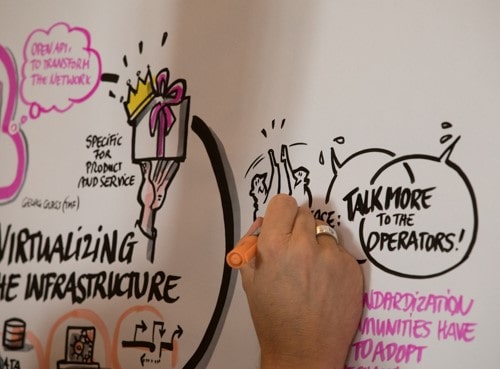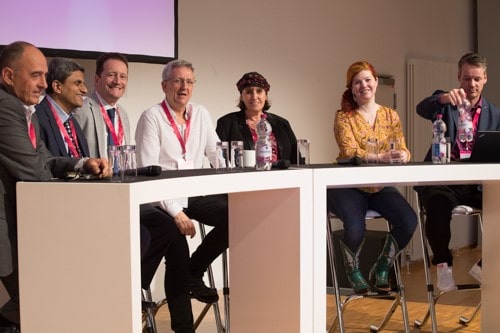Conference hosted by DT: Standardization meets open source to manage programmable networks
The Telco industry is heading towards a very interesting phase. Open source (OS) deployments are looking very promising. On the one hand there is the delivery of more flexible, simpler and agile deployments. On the other hand, the success of the current business is based on high quality solutions based on standards. There is no doubt that the success of the Telco industry will not attain the high current level without standards. ETSI, 3GPP, GSMA, etc. have done a great job.
But it is also clear that the way standards are created is evolving and taking on board the best of the open source community methods. An important discussion is how can both camps learn from each other.
Deutsche Telekom hosted a Conference on this topic at DT Headquarters in Bonn, on 9 and 10 September. The conference took place ahead the ETSI ZSM#8 workshop. The supporting organizations were ETSI, Linux Foundation and Telecom TV. Open Source Networking (OSN) Days of Linux Foundation were also embedded into the conference.
The purpose of the event was to discuss the enhancement of the collaboration and cooperation between SDO and OS. ETSI and LFN are good representatives of both parts of the industry. TM Forum (TMF) was invited as well.
200 experts from all parts of the industry were registered and discussed eight important areas of the industry.
Alex Jin-Sung Choi (Deutsche Telekom SVP) led the introduction:
I highly recommend his blog on LinkedIn.
Abdu Mudesir (Deutsche Telekom SVP) clarified the DT view on what has to change in the collaboration between SDO and OS. His message was: changing nothing is not an option. DT’s strategy is based on Full automation, model-driven approach towards Zero Touch, Big Data Analytics & AI/ML for future NSM.
- Drive Open Source collaboration together with Peers & Industry
- Open Source and Standards based solutions
 Orange, Telefonica, Sprint, NTT, Docomo, KDDI and Hutchison represented the strong voice of the operators.
Orange, Telefonica, Sprint, NTT, Docomo, KDDI and Hutchison represented the strong voice of the operators.
Beside the technology-based discussions, the need to change the Eco System consumed a significant amount of conference time. The transformation from a Hardware (HW) into a Software (SW) based industry has already started, yet the ECO System has not moved forward.
Alex Vul (Intel), Diego Lopez (Telefonica), Marisa S Viveros (IBM), Simone Catenacci (Accenture), Magnus Buhrgard (Ericsson) and Carlos Fernandes (Deutsche Telekom) discussed the controversial topic, with great spirit. Caroline Chappell (Analysys Mason) moderated the session.
Luis Romero (ETSI) presented a good overview on the collaboration process between ETSI and LFN. The MoU signed in April 2019 is a good indication that the level of discussion is at the right level.
Heather Kirksey (LFN) pointed out that LFN and ETSI have already established a good cooperation link. Concrete such as ETSI NFV-SOL 005 exist between ETSI NFV and ONAP. There is a common understanding that the process can be formalized further.
The event was well supported by numerous companies including Adidas, Accenture, Affirmed Networks, Amdocs, Intel, IBM, Nokia, Zalando, Cisco, NetCracker, Huawei, Ericsson, Orange, Telefonica, HPE, Red Hat, Juniper, Lumina, Lootse.
The final panel session was moderated by Guy Daniels (Telecom TV) with a summary and reflection on the two interesting days. Concrete actions were agreed:
- ETSI ISG ZSM and LFN ONAP to discuss alignment of the two architectures
- Planning of continued discussions on the ECO System over the coming months (Industry to describe roles and tasks in order to form a working eco-system)
- ZSM / ONAP to collaborate for 5G slicing. A concrete work item for a joint activity about network slicing for 5G is under discussion. Both groups are working on this topic. Another good example of collaboration is the discussion regarding the alignment of the ZSM Architecture and the ONAP Architecture. The first proposal of an architecture alignment was presented by Amdocs, Deutsche Telekom, Ericsson, Huawei and Nokia.
In Conclusion:
It seems that now is the right point in time to find a way on how the collaboration between SDOs and OS can be enhanced. Everybody involved sees the need for an improvement and is optimistic that this activity will be successful.
DT promised to facilitate the transformation and have already committed to prepare for a 2nd conference in September 2020.


